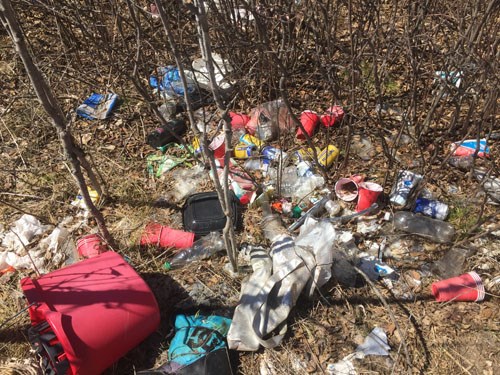Every year in the spring, when the snow melts away, we’re left with the garbage that’s been discarded and stuck in the snow, which sits along the side of the road or blows in the wind. It’s a disappointing sight as it means people are tossing garbage out their window without regard for nature.
It was a disappointing day for a local nature lover last week on Friday, April 28. In the spring, each year, she heads out to pick garbage along Moose Mountain Provincial Park’s Christopher Trail. Seeing the amount of litter tossed in the park is frustrating for her as it is not difficult to dispose of items properly: whether through recycling or to a trash container which is sent to a disposal site.
Fifteen facts about littering (www.conserve-energy-future.com)
1. It can create roadway accidents as vehicles attempt to avoid the debris
2. It is bad for the pocket book as you can be fined for littering. In Saskatchewan littering is prohibited, meaning “no person shall discard, or abandon or cause to be discarded or abandoned or allow to be discarded or abandoned, any waste: (a) on any land that is owned by another person or the Crown; or (b) into or on any water.” (The Environmental Management and Protection Act) The amount is determined on a case by case basis by a judge, but starts with a first offence at $200 for a person and $2,000 for a company.
3. The most common form of litter whether household, industrial, or construction waste is packaging.
4. Litter is a fire hazard.
5. It’s expensive as money is spent on cleaning litter up.
6. Litter has the potential to kill plants and animals: can the animal get caught in it, is it poisonous, etc…
7. On average, everyone has littered at some point in their life as they were unable to find a disposal site.
8. Litter can travel and doesn’t just affect where it has been tossed. It may travel via the wind or water systems in an area moving to a new location.
9. Cigarette butts are often tossed, but they take approximately 10 years to decompose, and are also a fire hazard if not put out properly.
10. A variety of reasons why people litter include simply being lazy and not wanting to carry their garbage out, they don’t realize the affects of littering, the garbage bins are too full, or simply don’t care.
11. The most commonly littered objects are fast food wrappers, paper, aluminium, glass, and plastic.
12. Litter can affect water quality.
13. Litter is able to be controlled because it is a human created issue. If people chose to stop littering there would be very little garbage found discarded.
14. It’s visually unpleasant.
15. Reducing litter is a three step process: stop littering, pick up litter, and report if you see someone littering.
Oftentimes people in vehicles decide to toss items out of the car. Instead of doing this bring along a small bag to place your garbage in for the journey and toss it out once you reach your destination.
If out walking or hiking, pack out what you pack in and leave nothing but footprints behind.
Overall, simply ensure that your garbage and recycling makes it into the proper bin.



